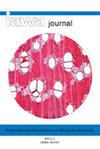Induction of compression wood inhibits development of spiral grain in radiata pine
IF 3.5
3区 农林科学
Q2 FORESTRY
引用次数: 1
Abstract
Spiral grain refers to the helical patterns formed by the wood grain in the trunks of many tree species. In most gymnosperms, grain near the pith is vertical but wood formed after several years of growth has a slight to pronounced left-handed twist. Grain changes presumably involve the slow rotation of cells within the vascular cambium, but the mechanisms that allow this reorientation to occur remain unclear. Understanding this process is, however, important as the presence of strong spiral grain within the corewood of gymnosperms is a major wood quality issue devaluing cut timber. In this study, we measured wood grain in stems of Pinus radiata (radiata pine) saplings through reconstructions of resin canals that follow the grain, visualised by serial sectioning and scanning with circularly polarised light, and through X-ray computed microtomography (μCT) and image analysis in ImageJ. Vertical trees retained a symmetrical grain pattern that was weakly right-handed near the pith, but which became progressively more left-handed during the first eight months of growth. In tilted trees, however, the development of left-handed grain was inhibited by the formation of compression wood on the lower side of the tree whereas the wood on the upper side of the tree developed increasingly more left-handed grain as in the vertical controls. These results demonstrate that a previously unidentified link exists between compression wood formation and the inhibition of grain development.压缩木材的诱导抑制了辐射松螺旋纹的发育
螺旋纹是指许多树种树干上的木纹形成的螺旋状图案。在大多数裸子植物中,髓附近的颗粒是垂直的,但经过几年生长形成的木材有轻微到明显的左旋扭曲。颗粒变化可能涉及血管形成层内细胞的缓慢旋转,但导致这种重新定向的机制尚不清楚。然而,理解这一过程很重要,因为裸子植物芯材中存在强烈的螺旋纹是使切割木材贬值的一个主要木材质量问题。在这项研究中,我们通过重建颗粒后的树脂管,通过连续切片和圆偏振光扫描,以及通过X射线计算机显微成像(μCT)和ImageJ中的图像分析,测量了辐射松(辐射松)幼树茎中的木纹。垂直树木在髓部附近保持着对称的右旋颗粒模式,但在生长的前八个月里,这种模式逐渐变得更加左旋。然而,在倾斜的树木中,左侧纹理的发育受到树木下侧压缩木材形成的抑制,而树木上侧的木材与垂直对照中一样,发育出越来越多的左侧纹理。这些结果表明,压缩木材的形成和颗粒发育的抑制之间存在着以前未确定的联系。
本文章由计算机程序翻译,如有差异,请以英文原文为准。
求助全文
约1分钟内获得全文
求助全文
来源期刊

IAWA Journal
农林科学-林学
CiteScore
3.40
自引率
15.80%
发文量
26
审稿时长
>36 weeks
期刊介绍:
The IAWA Journal is the only international periodical fully devoted to structure, function, identification and utilisation of wood and bark in trees, shrubs, lianas, palms, bamboo and herbs. Many papers are of a multidisciplinary nature, linking
 求助内容:
求助内容: 应助结果提醒方式:
应助结果提醒方式:


